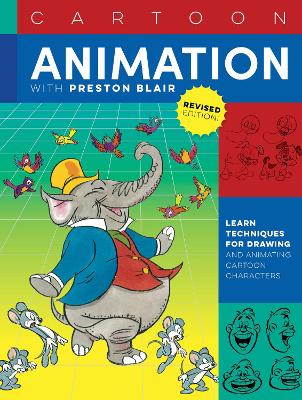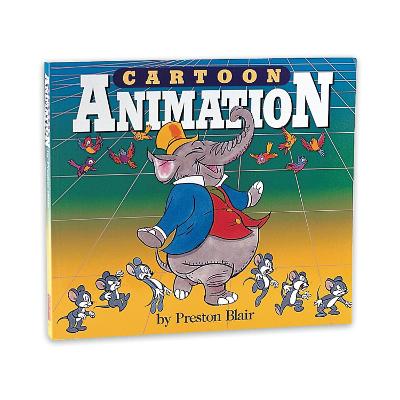Collector's
2 total works
By following the lessons in Cartoon Animation with Preston Blair, you can make any character—person, animal, or object—come to life through animated movement!
While animators must first know how to draw, the animation process involves much more than just good drawing skills. In this new edition, acclaimed cartoon animator Preston Blair shares his vast practical knowledge to explain and demonstrate the many techniques of cartoon animation. Learn the knowledge and skills animators must have, including:
THIS REVISED EDITION INCLUDES:
Chapter 1: Getting Started
Tools & Materials
Drawing Basics
Animation Methods
Chapter 2: Cartoon Construction
Parts of a Cartoon Character
The Body
The Head
Facial Expressions
The Hands
Chapter 3: Character Design & Development
Cartoon Examples
The Cute Character
The Screwball Type
The “Pugnacious” Character
More Animal Characters
Fictional People
Children
Chapter 4: Basic Character Movement
Comics to Life
Line of Action
Rhythm & Design
Basic Movement
Chapter 5: Animation
Principles
Beyond Simple Movements
Rough Sketches
Balance
Paths of Action
Animation Effects
Chapter 6: Animated Acting
Expressing an Attitude
Three Rules for Actors
Body Language
Dialogue
The Collector’s Series offers a broad range of projects across a variety of mediums and genres, such as drawing, oil, acrylic, watercolor, cartooning, calligraphy, and others. This series is suitable for beginning to intermediate artists, and each title features in-depth instruction about how to work with the tools of the trade, master techniques, and use newfound skills in practical application.
While animators must first know how to draw, the animation process involves much more than just good drawing skills. In this new edition, acclaimed cartoon animator Preston Blair shares his vast practical knowledge to explain and demonstrate the many techniques of cartoon animation. Learn the knowledge and skills animators must have, including:
- How to construct original cartoon characters by developing a character’s shape, personality, features, and mannerisms
- How to animate movements such as running, walking, dancing, posing, skipping, and more
- How to create realistic-looking mouth movements during dialogue, as well as body movements and facial expressions while the character is speaking
- The finer points of animating a character, including drawing key character poses and in-betweens
THIS REVISED EDITION INCLUDES:
Chapter 1: Getting Started
Tools & Materials
Drawing Basics
Animation Methods
Chapter 2: Cartoon Construction
Parts of a Cartoon Character
The Body
The Head
Facial Expressions
The Hands
Chapter 3: Character Design & Development
Cartoon Examples
The Cute Character
The Screwball Type
The “Pugnacious” Character
More Animal Characters
Fictional People
Children
Chapter 4: Basic Character Movement
Comics to Life
Line of Action
Rhythm & Design
Basic Movement
Chapter 5: Animation
Principles
Beyond Simple Movements
Rough Sketches
Balance
Paths of Action
Animation Effects
Chapter 6: Animated Acting
Expressing an Attitude
Three Rules for Actors
Body Language
Dialogue
The Collector’s Series offers a broad range of projects across a variety of mediums and genres, such as drawing, oil, acrylic, watercolor, cartooning, calligraphy, and others. This series is suitable for beginning to intermediate artists, and each title features in-depth instruction about how to work with the tools of the trade, master techniques, and use newfound skills in practical application.
In Cartoon Animation, acclaimed cartoon animator Preston Blair shares his vast practical knowledge to explain and demonstrate the many techniques of cartoon animation. By following his lessons, you can make any character—person, animal, or object—come to life through animated movement!
Animation is the process of drawing and photographing a character in successive positions to create lifelike movement. Animators bring life to their drawings, making the viewer believe that the drawings actually think and have feelings. Cartoon Animation was written by an animator to help you learn how to animate. The pioneers of the art of animation learned many lessons, most through trial and error, and it is this body of knowledge that has established the fundamentals of animation. This book will teach you these fundamentals.
Animators must first know how to draw; good drawing is the cornerstone of their success. The animation process, however, involves much more than just good drawing. This book teaches all the other knowledge and skills animators must have. In chapter one, Preston Blair shows how to construct original cartoon characters, developing a character’s shape, personality, features, and mannerisms. The second chapter explains how to create movements such as running, walking, dancing, posing, skipping, strutting, and more. Chapter three discusses the finer points of animating a character, including creating key character poses and in-betweens. Chapter four is all about dialogue, how to create realistic mouth and body movements, and facial expressions while the character is speaking. There are helpful diagrams in this chapter that show mouth positions, along with a thorough explanation of how sounds are made using the throat, tongue, teeth, and lips. Finally, the fifth chapter has clear explanations of a variety of technical topics, including tinting and spacing patterns, background layout drawings, the cartoon storyboard, and the synchronization of camera, background, characters, sound, and music.
Full of expert advice from Preston Blair, as well as helpful drawings and diagrams, Cartoon Animation is a book no animation enthusiast should be without.
Animation is the process of drawing and photographing a character in successive positions to create lifelike movement. Animators bring life to their drawings, making the viewer believe that the drawings actually think and have feelings. Cartoon Animation was written by an animator to help you learn how to animate. The pioneers of the art of animation learned many lessons, most through trial and error, and it is this body of knowledge that has established the fundamentals of animation. This book will teach you these fundamentals.
Animators must first know how to draw; good drawing is the cornerstone of their success. The animation process, however, involves much more than just good drawing. This book teaches all the other knowledge and skills animators must have. In chapter one, Preston Blair shows how to construct original cartoon characters, developing a character’s shape, personality, features, and mannerisms. The second chapter explains how to create movements such as running, walking, dancing, posing, skipping, strutting, and more. Chapter three discusses the finer points of animating a character, including creating key character poses and in-betweens. Chapter four is all about dialogue, how to create realistic mouth and body movements, and facial expressions while the character is speaking. There are helpful diagrams in this chapter that show mouth positions, along with a thorough explanation of how sounds are made using the throat, tongue, teeth, and lips. Finally, the fifth chapter has clear explanations of a variety of technical topics, including tinting and spacing patterns, background layout drawings, the cartoon storyboard, and the synchronization of camera, background, characters, sound, and music.
Full of expert advice from Preston Blair, as well as helpful drawings and diagrams, Cartoon Animation is a book no animation enthusiast should be without.

